The Essential Piccolo
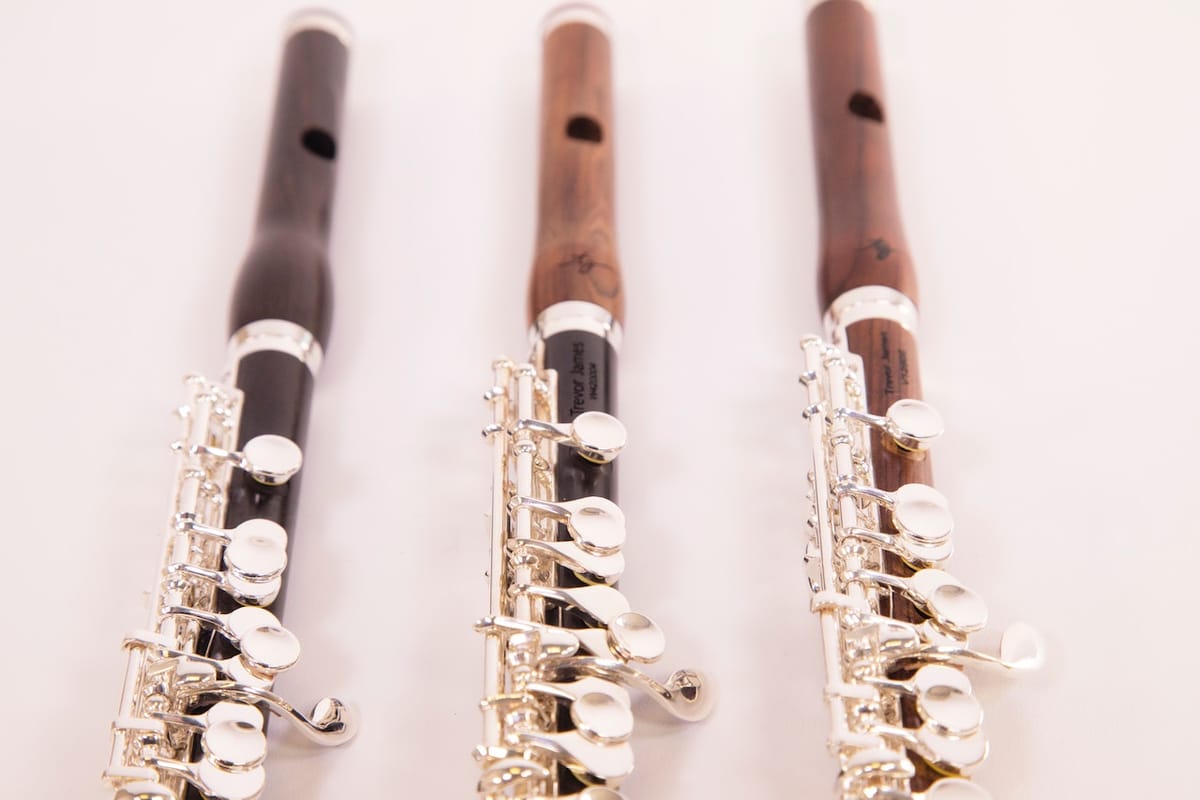
“I don’t own a piccolo,” was one of the first statements the principal flutist of a local community orchestra claimed as she watched me finding my place at the bottom end of the section and beginning to set up the stand for my piccolo, concert, and alto flutes. How sadly familiar was this comment which fell upon my ears! It reminded me of one of the first interactions I had a few years earlier with the principal flutist of a concert band, when he proudly claimed that he never played his old, poor-quality piccolo (which at least he owned!) Somehow, these comments seemed translatable into “I don’t need to play the despicable picc., for I am always respected for my flute playing.” I also recall another flute teacher’s advice to her students, “Don’t get too interested in the piccolo!” Thinking back to my own flute lessons with my major teachers—all principal flutists of their orchestras—I seem to remember, that without my initiating the topic, none of them ever mentioned the piccolo. Even Boehm, the designer of our modern flute and champion of the alto flute, did not particularly care for the piccolo, ultimately leaving the serious work of adapting his system to the piccolo to his apprentice, Thomas Mollenhauer.
First flutists rarely tell the stories of the piccolo. Neither do entries in music dictionaries and encyclopaedias, which in Darwinian fashion, seem to recount only the details of progress that have led to today’s standard-sized Boehm flute. Therefore, what little we do know about the piccolo is likely based upon our current lived experience as players: the current purchasing options, the repertoire we learn to play, and the present social status afforded to us within our music-making activities. As we find ourselves occupying the “auxiliary”, “utility” or “third” flute position in the orchestral world, or feeling like a solitary outlier in a band’s large and otherwise homogeneous flute section, we may sense that through our association with this less-than-treasured instrument, we inhabit a marginalized sphere of diminished status. (And yes, is it not sad that some of the strongest vitriol aimed at our little instrument originates from flutists, themselves?)
We wonder if this unfortunate, low caste position for the piccolo, especially within the flute section, has always existed. Informed by flute histories alone, of course there are gaps in information about the piccolo’s development which cause a considerable amount of fuzziness. What is the piccolo’s function anyway, its lineage or even its actual musical identity? Without a basic awareness of its own specific history, piccolo players can only view their sphere from its current position. However, with a piccolo-focused re-examination of musical materials from earlier times, this article will serve to bring to light the very different social and musical position held by piccolo players of the past, especially in bands.
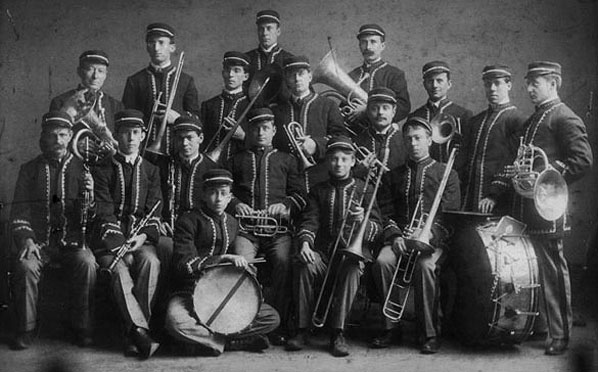
During the golden years of band music of the late nineteenth and early twentieth century, the large flute sections, to which we are so accustomed today, simply did not exist. Many bands had no flute section at all, but rather just one, singular piccoloist, a player who, on occasion, might also be required to play a larger flute. Soaring an octave above the clarinets and (valved) trumpets or cornets, this solitary piccolo would offer its indispensable brilliance to the overall melodic texture. In his catalogue of Band Music of the French Revolution (2015), David Whitwell reveals a remarkable number of overtures, marches and patriotic songs of the late 1700s and first years of the 1800s, requiring the services of one or often two “petite flute” (piccolo) players; far less often is there call for one or two “grande” flutes and mostly that is in addition to the two petite flutes.1 Thus, with the French Revolution in the historic origins of the wind band, we find that it is the piccolo (petite flute), along with the clarinet, listed as the essential woodwinds.
With the introduction of valves to brass instruments early in the nineteenth century, the all-brass band became widely popular. Industrial mills and collieries engaged their workers outside working hours in music-making as a positive, community-building pastime. Due to their capacity for technical facility, occasionally a clarinet and/or a piccolo, (but not the larger flutes) were added to some of these ensembles. In his study of the early nineteenth century American brass bands, Roy Newsome (1998) extols the piccolo, “. . . its shrill sound lending itself to open air performance, and providing a super-octave melody line” as an useful asset for a number of existing brass bands.2 Heather Coleman’s (1999) dissertation additionally furthers our knowledge about the important role that the piccolo played in these bands, despite the widespread tendency then to dissuade its use, in the drive to keep these ensembles exclusively of brass and percussion.3

By the later decades of the nineteenth century, bands lay at the very core of social life. In this era prior to recorded music, and as interest began to wane in the homogeneous sound of brass bands, the addition of woodwinds offered a much wider range of tonal possibilities to them. Much public attention was given to the live music events presented by Gilmore’s Band in America, the massive ensembles in Britain and the Continent led by Jullien, the French piccolo-playing and conducting sensation, and by the many local military, industrial, and community bands.
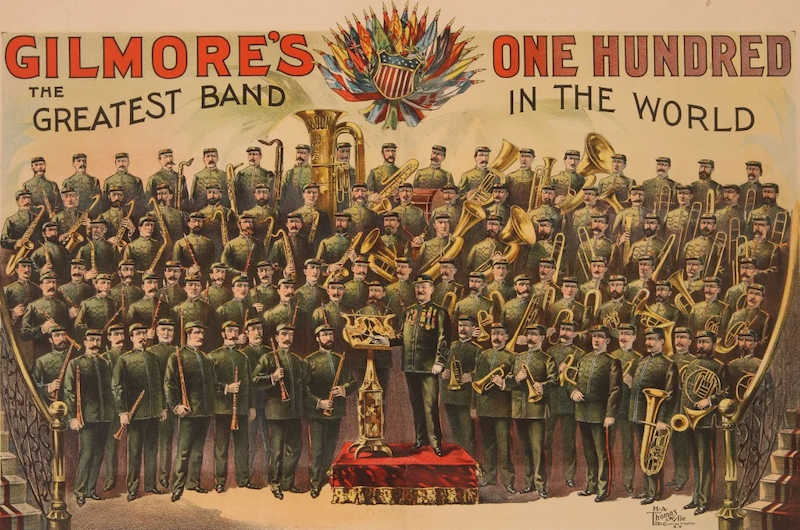
The Band Teacher’s Assistant
While most band leaders were limited by the instruments and the players available in the vicinity, Clappé, nevertheless, offered the following specifications for the ideal instrumentation of this type of brass and reed band:
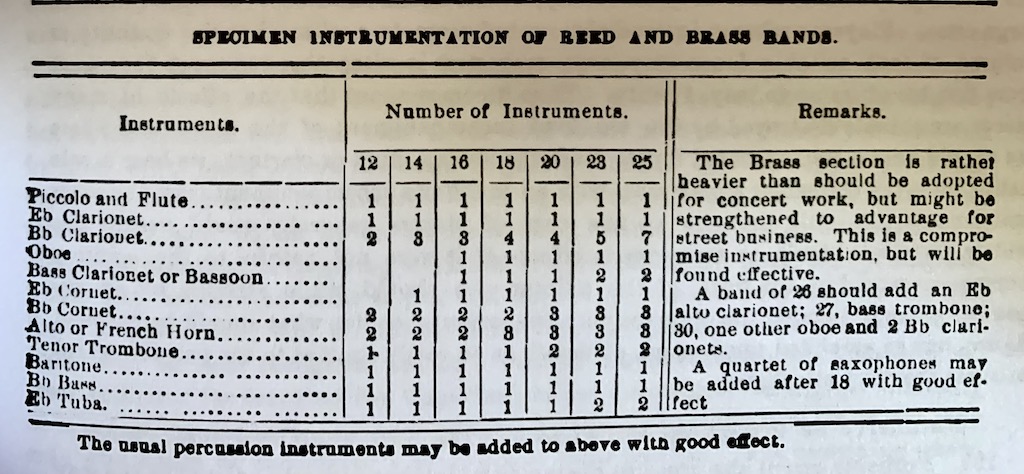
From this list, we can make three observations that are significant for the piccolo player. First, the designation is for a piccolo player who also doubles as a flutist, not a flutist who might occasionally play piccolo. Later, in the text under “Characteristics of the Instruments,” the only woodwinds that receive their own descriptions are the piccolo (but not the flute) and the clarionet (sic), with the piccolo possessing more commentary in the text than any other instrument except for the cornet. Second, mandatory doubling is not expected of any other wind musician, not even the clarinetists. Finally, even as the band increases in number from twelve to thirty players (or thirty-four with saxophones), a second piccolo/flute player is never recommended, even when several clarinetists and a second oboist are added.
Four decades later in the 1920’s and because of some widely differing instrumentations in the competing bands at the first MENC (Music Educators National Conference) National (U.S.A) School Band Contest, Joseph Maddy (1957) informs us that a movement to standardize concert bands occurred. The following balance for a model 68-piece ensemble was suggested:
2 flutes or piccolos (interchangeable); 2 E-flat clarinets; 2 oboes; 1 English horn; 24 B-flat clarinets; 2 alto clarinets; 1 bass clarinet; 2 alto saxophones (or 1 soprano; 1 alto); 1 tenor saxophone; 1 baritone saxophone; 1 bass saxophone; 2 bassoons; 2 B-flat cornets; 2 B-flat trumpets; 2 B-flat fluegelhorns ; 4 French horns; 3 trombones; 2 baritones; 2 E-flat tubas; 2 BB-flat tubas; timpani and drums5
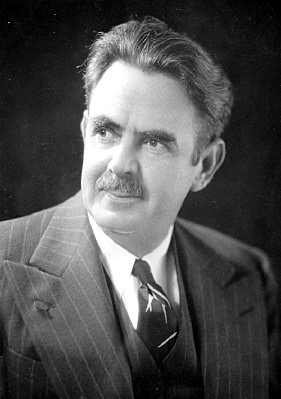
Of note here is the enormous clarinet section of 24 players. It was especially stated by the standardizing committee that, in the concert band, the instruments of the clarinet choir would serve as the substitutes for the missing string section of the orchestra.6 Through this, a much more symphonic repertoire could be accommodated, thereby raising the standards of repertoire (as well as musical status) of a standardized wind band. Again with this listing, we note that the only players in the band of dual, exchangeable instrument responsibility (other than percussionists) are the two piccolo/flute players. Unlike the instrument distribution found in many of today’s bands, there would be no more flutists than oboists, and that while the English horn (cor anglais) would engage a separate, specialist (and third) player, all flute work remained the responsibility of the two piccoloists.
Another four decades later we see from Charles Osborne’s study (1962) that the flute/piccolo sections in American school bands had not sustained this notion.
“Many flute sections are growing entirely too large and the band director is casting about for a place for the abundance of flutists. By putting some of the players on the Eb instrument, he (sic) is able to spread the range of his flute section and to accommodate more players in the group. Thus this instrument (the Eb soprano flute) has a definite place in the organizations of today and is available at very reasonable prices.”
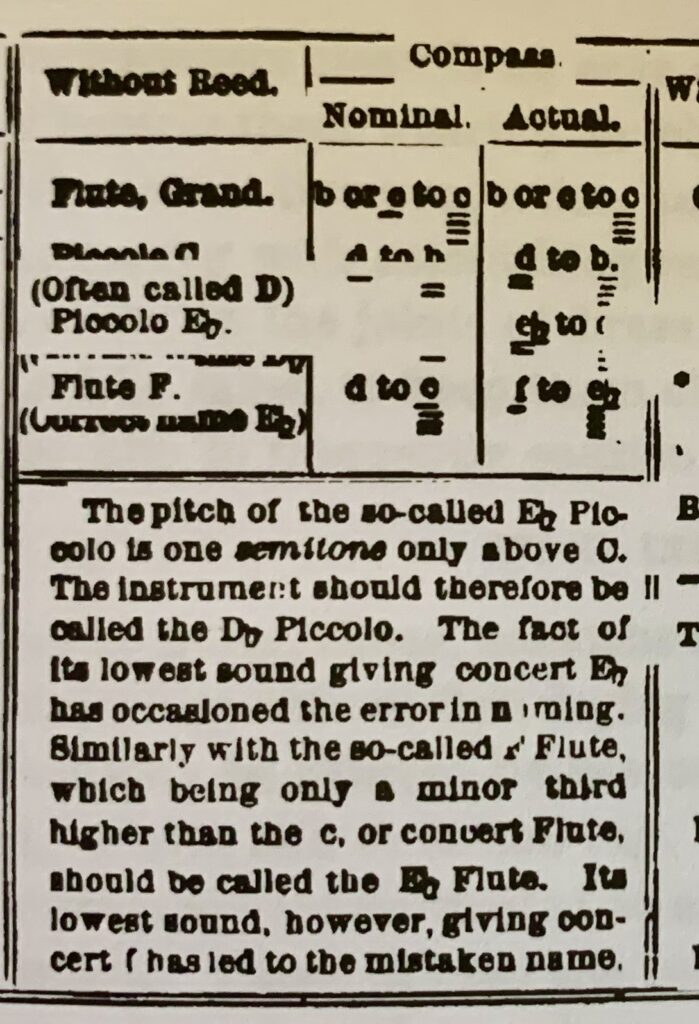
Here, even by the early 1960s, not only is it evident that the flute had become a popular choice of instrument for music students, but that the duality of the flute/piccolo responsibility had been broken. However, Osborne’s recommendation for expanding performance possibilities for flutists through the use of the E flat soprano flute (formerly known as tierce flute or flute in F) as a substitute for the E flat clarinet, saw very little implementation.
It is interesting to note that Clappé much earlier also mentioned the Eb flute in his explanation of the pitch-naming of the flute family, even though this instrument does not appear on his suggested band instrumentation list. Yet well before Clappé, and more than a century earlier than Osborne, Hector Berlioz (1844) too, advocated the use of the third (or tierce) flute8 and used two of them along with two piccolos in his Symphonie Funebre et Triomphale (1840).
The popularity of the flute, without obligatory piccolo responsibilities, continues to grow in school music programmes into the twenty-first century to the extent that Heather Joy McWilliams (2003) mentions the severe and distressing imbalance of membership in the University of Wisconsin at Oshkosh Symphonic Band. When more than a quarter of the players (a total of 23) who registered were flute players,9 a crisis resulted in that such impossible instrumentation could not provide satisfactory music-making for either the performers or their audience. Not an isolated occurrence, this trend of the social dominance of sheer numbers of flute players in schools has seriously altered the original intent of the flute as a solo voice of colour within the band. Yet, while the current flute population has created a core of “tutti” players, much of the repertoire they perform does not recognize them in this expanded capacity. Socially too, the enlarged flute section has isolated the piccolo, creating a marginalized role for its lone player—a role whose function is regularly misunderstood by those who do not play the instrument.
Most of the compositions and arrangements that bands currently play still reflect the conceptual writing of the ideal bands of a century ago. Frederick Fennell (1954) claims that the first significant work for wind band was Holst’s Suite in Eb (1909).10 For that classic work, as well as Holst’s Second Suite in F (1911) and Vaughan Williams’ English Folk Song Suite(1924), the expectation was that it would be only one player who would fill both the piccolo and flute requirements. While this player would be featured on the larger flute in the quieter, more thinly-scored moments such as the middle sections of the movements “Chaconne” or “My Bonny Boy”, most of the actual playing was to be carried out on piccolo. Therefore, those piccolo-specific passages would not originally have been doubled by flute(s) at the lower octave, the way we always hear them today.
Thus due to the current overpopulation in band flute sections, we experience practices that do not align themselves with the original intent of much of the repertoire, especially in the earlier twentieth century compositions. With a massive flute majority shaping the social focus of the section, the piccolo has become recast in a role of outlier or accessory—a 180˚ shift from the ideals presented during the 1800s to the 1920s. Frustrated by tuning and volume issues from an over-populated flute section, is it any wonder that few band directors are eager to increase the flutes’ presence by adding a piccolo to the fray? It might seem that the cautionary words of Arthur Clappé:
“In the hands of a good performer it [the piccolo] may be made extremely effective; but in indifferent hands is treacherous and revengeful, displaying a tendency to fly off at a tangent from the true pitch, that is particularly distressing to the sensitive ears and harrowing to the soul of a band leader.” 11
. . still resonate, often resulting in no one being assigned to play the piccolo in some school and community bands. In such cases any composer’s intentional moments of top octave shimmer just do not occur. As the attentiveness to period authenticity has led to choices of historically correct instruments and instrumentation to be used in many orchestras and chamber works, this happens only very rarely in the world of band music. Despite our awareness of this extensive change of aural balance from the bands of yesteryear, there is little we can readily do in order to remedy the over-application of flute sound to the present-day band’s colour palette without the denying of a substantial quantity of flutists the opportunity of performing. However, now knowing the piccolo’s proud heritage, originally so central to the wind band, will serve to reify its identity and to affirm our sense of its essential contribution.

References:
- Whitwell, David. (2015). Band Music of the French Revolution. 2nd edition. Austin, TX: Whitwell Books, pp.122-253.
- Newsome, Roy. (1998). Brass Roots: a Hundred Years of Brass Bands and their Music (1836-1936). Aldershot, England: Ashgate, p. 4.
- Coleman, Heather. (1999). The Adoption and Role of the D-Flat Piccolo and Other High Band Flutes in the Nineteenth Century American Amateur Band. University of Memphis: Doctoral Dissertation.
- Clappé, Arthur. (1888). The Band Teacher’s Assistant or Complete and Progressive Band Instructor Comprising the Rudiments of Music, and Many Valuable Hints on Band Topics, with Charts Showing Compass of All Instruments, and Fingerings of Piccolo, Clarionet, Cornet, Alto, Tenor, Baritone and Tuba, as well as Positions on Slide Trombone. New York: Carl Fischer, p.27.
- Maddy, Joseph E. (1957). The Battle of Band Instrumentation. Music Educators Journal, 44 (1) 30, 32, 35. p.32.
- Ibid, p.32.
- Osborne, Charles E. (1962). Pedagogical Application of Flute Study to Teachers’ Needs. Michigan State University: PhD. Dissertation, p.145.
- Berlioz, Hector. (1844/1858). A Treatise on Modern Instrumentation and Orchestration. London: Novello, p.125.
- McWilliams, Heather Joy. (2003). Gender equity issues in the depiction of Females in The Instrumentalist magazine August 2000 – July 2002. University of Wisconsin at Madison: PhD. Dissertation, p.6.
- Fennel, Frederick. (1954). Time and the Winds. Kenosha, WI: Leblanc Publications, p. 35.
- Clappé, Arthur. (1888). The Band Teacher’s Assistant or Complete and Progressive Band Instructor… p. 33.
This article originally appeared in International Flute Journal and is used by kind permission.





